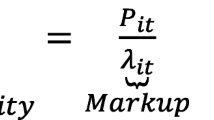Abstract
Academic and corporate research departments alike face a crucial dilemma: to exploit known frameworks or to explore new ones; to specialize or to innovate? Here I show that these two conflicting epistemic desiderata are sufficient to explain pluralistic ignorance and its boom-and-bust-like dynamics, exemplified in the collapse of the efficient markets hypothesis as a modern risk management paradigm in 2007. The internalist nature of this result, together with its robustness, suggests that pluralistic ignorance is an inherent feature rather than a threat to the rationality of epistemic communities.





Similar content being viewed by others
Notes
See Strevens (2003) for a discussion of a model of the distribution of cognitive labor containing only decreasing marginal returns.
“To take an example, therefore, from a very trifling manufacture; but one in which the division of labour has been very often taken notice of, the trade of the pin-maker; a workman not educated to this business (which the division of labour has rendered a distinct trade), nor acquainted with the use of the machinery employed in it (to the invention of which the same division of labour has probably given occasion), could scarce, perhaps, with his utmost industry, make one pin in a day, and certainly could not make twenty. But in the way in which this business is now carried on, not only the whole work is a peculiar trade, but it is divided into a number of branches, of which the greater part are likewise peculiar trades. One man draws out the wire, another straights it, a third cuts it, a fourth points it, a fifth grinds it at the top for receiving the head; to make the head requires two or three distinct operations; to put it on, is a peculiar business, to whiten the pins is another; it is even a trade by itself to put them into the paper; and the important business of making a pin is, in this manner, divided into about eighteen distinct operations, which, in some manufactories, are all performed by distinct hands, though in others the same man will sometimes perform two or three of them. I have seen a small manufactory of this kind where ten men only were employed, and where some of them consequently performed two or three distinct operations. But though they were very poor, and therefore but indifferently accommodated with the necessary machinery, they could, when they exerted themselves, make among them about twelve pounds of pins in a day. There are in a pound upwards of four thousand pins of a middling size. Those ten persons, therefore, could make among them upwards of forty-eight thousand pins in a day” (Smith 2003, pp. 8–9).
The number of possible connections in such a network of improvements is \(n(n-1)\) with \(n\) the total number of improvements.
The more interconnected a community, the more opportunities for specialization. While \(C\) and \(T\) indicate the current and total size of the framework, I suggest to interpret \(s\) as an empirical parameter indicating the degree of interconnectedness of the social community constituting the framework.
The notions “classificatory scheme” and “paradigm” are used interchangeably for the purpose of this paper.
This model was coded in Netlogo v.4.1.3. The code of this model can be obtained from the author.
In this model classificatory schemes are distinguished using colors. Netlogo allows 1,400 colors from which each agent draws a random color at setup.
For expository purposes I restricted description of this model in the previous section to two paradigms (“established” and “defectors”) but because agents can endogenously create new paradigms there is no limit to the number of paradigms.
References
Bernanke, B. (2004). The great moderation. Speech delivered in the capacity of Governor of the Federal Reserve at the meetings of the Eastern Economic Association, February 20, 2004. http://www.federalreserve.gov/Boarddocs/Speeches/2004/20040220/.
Bicchieri, C. (2006). The grammar of society: The nature and dynamics of social norms. Cambridge: Cambridge University Press.
Carnap, R. (1950). Logical foundations of probability. Chicago: Chicago University Press.
Centola, D., Willer, R., & Macy, M. (2005). The emperor’s dilemma: A computational model of self-enforcing norms. American Journal of Sociology, 110(4), 1009–1040.
Greenspan, A. (2008). Testimony before the house of representatives. Testimony in the capacity of Chairman of the Federal Reserve Speech before the House of Representatives, October 23, 2008. http://oversight-archive.waxman.house.gov/documents/20081023100438.pdf.
Kuhn, T. (1970). The structure of scientific revolutions (2nd ed.). Chicago: Chicago University Press.
Lucas, R. (2003). Macroeconomic priorities. Presidential address to the American Economic Association, January 4, 2003. http://bit.ly/1h6EYK0.
Miller, D., & McFarland, C. (1991). When social comparison goes awry: The case of pluralistic ignorance. In J. Suls & T. Wills (eds) Social comparison: Contemporary theory and research (pp. 287–313). Hillsdale: Lawrence Erlbaum Associates.
O’Gorman, H. (1986). The discovery of pluralistic ignorance: An ironic lesson. Journal of the Historic and Behavioral Sciences, 22(4), 333–347.
Smith, A. (2003). Wealth of nations. New York: Bantam Classics (1776).
Solow, R. (1988). Private correspondence. Correspondence between Alan Kirman and Robert Solow, April 1988. http://www.bankofengland.co.uk/publications/Documents/events/ccbs_cew2010/presentation_kirman.pdf.
Strevens, M. (2003). The role of the priority rule in science. Journal of Philosophy, 100(2), 55–79.
Turner, A. (2010). Economics, conventional wisdom and public policy. Speech delivered in the capacity of Head of the U.K. Financial Services Authority to the Inaugural Conference of the Institute of New Economic Thinking, April 9, 2010. http://bit.ly/IjxXXc.
Wray, B. (2011). Kuhn’s evolutionary social epistemology. Cambridge: Cambridge University Press.
Acknowledgments
The author thanks the participants of the 4th Copenhagen Lund Workshop in Social Epistemology for comments and discussion. In particular he would like to thank its organizer Frank Zenker for many helpful comments and suggestions during the editorial process.
Author information
Authors and Affiliations
Corresponding author
Rights and permissions
About this article
Cite this article
De Langhe, R. To specialize or to innovate? An internalist account of pluralistic ignorance in economics. Synthese 191, 2499–2511 (2014). https://doi.org/10.1007/s11229-014-0436-z
Received:
Accepted:
Published:
Issue Date:
DOI: https://doi.org/10.1007/s11229-014-0436-z



